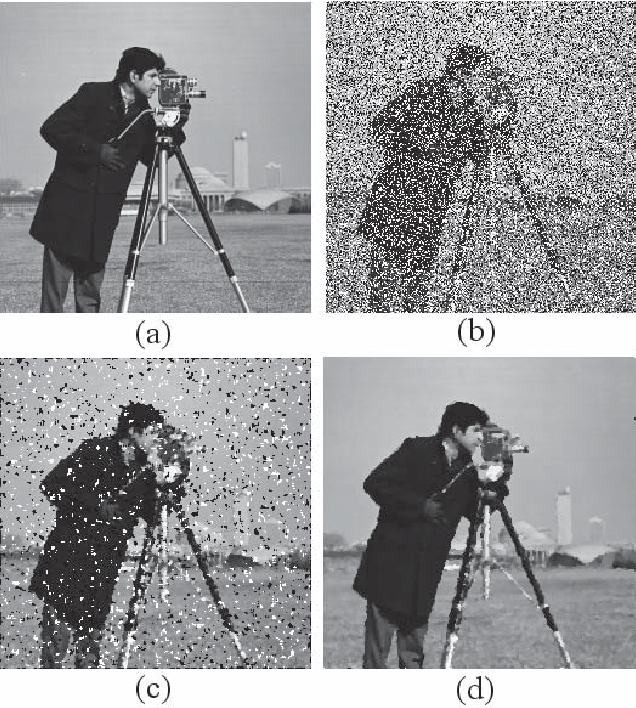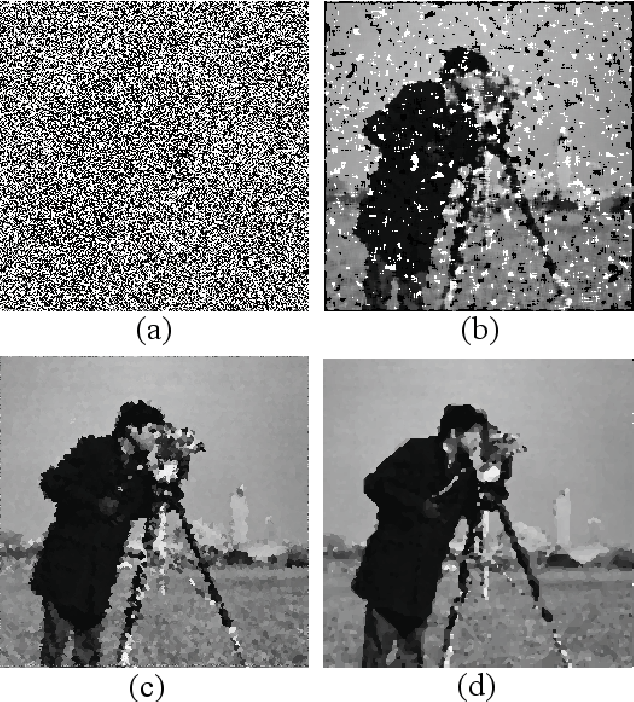Regularized Median Filter

Fig. 1: (a) Cameraman image; (b) 50% salt and pepper noise added; (c) 3-by-3 median filter; (d) 3-by-3 median filter with 3-by-3 spatial regularization.

Fig. 2: (a) 90% salt and pepper noise added to Cameraman image; (b) 5-by-5 median filter; (c) DBF method; (d) 5-by-5 median filter with 5-by-5 spatial regularization.
We provide a novel formulation for computing median filter with spatial regularization as minimizing a cost function composed of absolute value norms. We turn this cost minimization into an equivalent linear programming (LP) and solve its dual LP as a minimum cost flow (MCF) problem. The MCF is solved over a graph constructed for an input image, and the primal LP solution is retrieved as the filtered image. For solving the MCF, we utilize an efficient network simplex algorithm. Numerical results show that the proposed median filter with a spatial regularization term outperforms median filters and a decision theoretic filter (DBF) for impulse noise removal.
Related Publication
- N. Ray, “Median filter with absolute value norm spatial regularization,” Proceedings of IEEE ICASSP 2011, pp. 1437-1440, 2011.
Inclusion Filter

Fig. 1: (a) Image of an eagle. The user has mouse-clicked inside the head and neck of the eagle (five black dots). (b) After inclusion filtering, the eagle image with the markers (five black dots). (c) Canny edges of (a). (d) Canny edges of (b).
We define a connected operator that either fills or retains the holes of the connected sets depending on application-specific criteria that are increasing in the set theoretic sense. We refer to this class of connected operators as inclusion filters, which are shown to be increasing, idempotent, and self dual (gray-level inversion invariance). We demonstrate self duality for 8-adjacency on a discrete Cartesian grid. Inclusion filters are defined first for binary-valued images, and then the definition is extended to grayscale imagery. It is also shown that inclusion filters are levelings, a larger class of connected operators. Several important applications of inclusion filters are demonstrated-automatic segmentation of the lung cavities from magnetic resonance imagery, user interactive shape delineation in content-based image retrieval, registration of intravital microscopic video sequences, and detection and tracking of cells from these sequences. The numerical performance measures on 100-cell tracking experiments show that the use of inclusion filter improves the total number of frames successfully tracked by five times and provides a threefold reduction in the overall position error.
Related Publications
- N. Ray, B. Saha, S.T. Acton, “Oil sand image segmentation using the inclusion filter”, invited paper in special session on connected operators.at IEEE ICIP 2008, pp.2188–2191, 2008.
- N. Ray and S.T. Acton, “Inclusion filters: a class of self-dual connected operators,” IEEE Transactions on Image Processing, vol. 14, no.11, pp. 1736-1746, Nov. 2005.
- N. Ray and S.T. Acton, “Self-dual inclusion filters for grayscale imagery,” Proceedings of IEEE ICIP, vol.1, pp. 321-324, Barcelona, Spain, September 14-17, 2003.